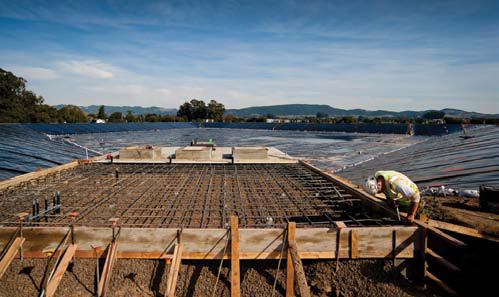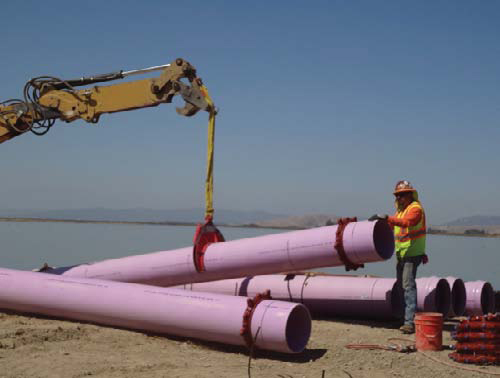Municipal Water Reuse Done Right: Lessons In Efficiency
By Barry Dugan, Data Instincts, Public Outreach Consultants
California water reuse program provides multiple benefits, serving as a model for other municipalities.
Just to the north of San Francisco, where the shores of San Pablo Bay give way to the coastal hills and valleys that are home to California’s premium wine country, a regional water reuse program is stretching limited drinking water supplies by utilizing the latest in treatment technologies to recycle the region’s valuable water resources. Highly treated wastewater that is permitted for discharge into the bay is being reused for multiple benefits: to enhance wildlife habitat, protect groundwater, irrigate world-class vineyards, and keep parks and golf courses green.
The North Bay Water Reuse Program (NBWRP) is a coordinated effort of three counties and seven water and sanitation agencies, working together as one entity to address water supply shortages from a watershed perspective. The region is not immune from the water scarcity issues that persist throughout the arid west: The North Bay counties of Sonoma, Napa, and Marin face long-term water supply challenges. Surface and groundwater supplies are stretched to their limit. Some groundwater sources are over-pumped and threatened with seawater intrusion. A reliable supply of recycled water not only offsets limited potable water, but provides a variety of benefits that support the area’s quality of life.

As part of the NBWRP, the Sonoma Valley County Sanitation District completed this reservoir storage project that provides storage of up to 100 acre-feet of water that can be used on a year-round basis by grape growers.
From its inception, the NBWRP has approached water recycling by providing multiple benefits for multiple end users and has planned for treatment, storage, and distribution projects that meet the broadest needs of its members. An example of a multiple-benefits project is the recent construction of a pipeline that serves high-value, winegrape growers on the way to providing water for wetlands and riparian habitats.
By using this multiple-benefit approach, the NBWRP is able to offset urban and agricultural demands on potable supplies and impacted groundwater basins, enhance local and regional ecosystems, improve local and regional water supply reliability, maintain and protect public health and safety, promote sustainable practices, give top priority to local needs for recycled water, and implement facilities in an economically viable manner.
A key to the success of the program is the support of both state and federal agencies. The U.S. Bureau of Reclamation has been a partner in developing the recycled water program. The State of California is also a partner, and the NBWRP’s watershed approach is consistent with their Integrated Water Resources Planning program.
When the NBWRP was undertaken in 2001, it was envisioned as a two-phase program. Phase 1 is 65 percent complete and valued at $104 million. Phase 1 provides 3,800 acre-feet/year (AFY) of water for irrigation and up to 1,700 AFY for environmental restoration. This includes 46 miles of pipeline, 100 AFY of storage, and 6.5 MGD of new tertiary treatment. Phase 2 is in the planning stage and is estimated at $150 million in projects, which will build on the Phase 1 infrastructure by increasing storage, distribution, and groundwater management. When fully implemented, the program will yield 33,000 AFY of recycled water.
Treatment Technologies And Partnerships
Recycled water produced by NBWRP projects meets or exceeds the standards established by the State of California Department of Health Title 22 Code of Regulations and is approved for use in a variety of applications, including irrigation of food crops, parks and playgrounds, school yards, and residential landscaping. The treatment process and the technologies utilized are determined by each agency, depending on their needs and the end user.
The Las Gallinas Valley Sanitary District (LGVSD) completed a new advanced Recycled Water Facility in 2012. The $8 million project was funded in part by $1.6 million in federal and state funds obtained through the district’s participation in the NBWRP. The facility utilizes ultrafiltration and UV disinfection to produce up to 0.7 MGD of tertiary recycled water with full redundancy. LGVSD partnered with another NBWRP member, the North Marin Water District (NMWD), to distribute the recycled water to customers to the north of the facility. NMWD distributes the water throughout its service area to schools, parks, and commercial landscape users.
LGVSD designed the facility to be expandable up to 5.4 MGD, which can be accomplished by simply installing additional filtration units, according to District General Manager Mark Williams. The recycled water facility includes two ZENON ZeeWeed 1500 ultrafiltration membrane units, with current capacity of 0.7 MGD each, but can be expanded to 1.35 MGD. The two Trojan UVFit ultraviolet disinfection system units each have a capacity of 1.8 MGD.
“We started with a small plant, but as we worked through the design process, our board and staff recognized the importance of having it readily expandable,” he said. “One of the unique features is our ability to add plug and play filtration units that come on a skid.” Williams also noted that the ultrafiltration and UV disinfection treatment technologies provide the first step in a direct or indirect potable reuse process. “We selected this technology in anticipation of potable reuse, should it become a treatment option as the first step in that process,” he said.
The Napa Sanitation District (NSD) has leveraged its participation in the NBWRP to fund a portion of its expanded recycled water facility. The district produces about 2,200 AFY of tertiary quality recycled water that it distributes to nearby customers for irrigation of golf courses, industrial and commercial landscaping, schools, and parks. The NSD also uses recycled water on its own property to raise fodder crops.
All of the wastewater at the NSD plant receives secondary treatment, utilizing both activated sludge and pond treatment methods. For the tertiary quality recycled water, the NSD expanded its capacity by adding additional Dynasand continuous backwash sand filters to its existing system. After going through the sand filter treatment, the recycled water receives extended chlorination. The facility is designed with the capability of adding additional components as demand for recycled water increases. To date, the NSD has spent $15.3 million on the project and received $2.1 million federal and state funding. It anticipates additional federal grant funding for the project.
Storage Is A Key Component
Because demand for recycled water is greatest during the dry summer months, storage during off-peak months is a critical component of any water reuse program. In Phase 1, the Sonoma Valley County Sanitation District completed a reservoir storage project that provides storage of up to 100 acre-feet of water that can be used on a year-round basis by grape growers. The Sonoma Valley system also includes two large storage reservoirs, with a capacity of 355 acre-feet, that can be used for vineyard irrigation, and it also provides water for habitat enhancement for wildlife, including a variety of waterfowl and other birds.
The NBWRP’s next phase will include a greater emphasis on storage, with as many as 18 storage projects in the planning stages, including projects that will again integrate multiple benefits into their design. For example, a storage pond could provide habitat enhancement for wildlife, protection against sea-level rise, assist with groundwater recharge, and provide community recreation and open space.
Recycled water is distributed to a variety of locations in the program area for a variety of uses. The Novato Sanitary District and the Las Gallinas Valley Sanitary District treatment facilities both provide water to the North Marin Water District, where it is distributed to its customers for irrigation landscaping, parks, playgrounds, and a golf course.
Environmental Benefits For Fish And Wildlife
The NBWRP has gone beyond the traditional uses for recycled water by including a significant habitat restoration project: the Napa-Sonoma Marsh Restoration Project. This is a multiagency effort, involving the Sonoma County Water Agency, Sonoma Valley County Sanitation District, California Department of Fish and Wildlife, the Army Corps of Engineers, the state Coastal Conservancy, and federal Bureau of Reclamation. Recycled water from the Sonoma Valley County Sanitation District will be used to dilute a 300-acre pond that was formerly used to produce salt. The highly saline contents of the pond could, if left in its current condition, harm fish and wildlife if a storm or flood breached the levees surrounding the pond. By diluting the contents of the pond with fresh recycled water, the salty mixture can be slowly released into the nearby San Pablo Bay.
The Napa-Sonoma Marsh Restoration Project, which is expected to take up to 10 years to complete, has additional environmental benefits. The NBWRP provided the 3.5-mile pipeline that carries water to the salt pond. The pipeline travels through the Carneros wine-growing region, a notoriously dry region where the groundwater basin is under pressure from urban development and agriculture. Studies have indicated groundwater levels are dropping, and there is the threat of seawater intrusion.
Grape growers along the pipeline route now have access to the recycled water for vineyard irrigation, decreasing pressure on groundwater and allowing much higher yields for the world-class vineyards. Vineyards in the Carneros region are farmed with very little water, and yields are typically about one ton to the acre. With abundant water for irrigation, those yields could triple or quadruple, providing additional economic benefits to the region.
Program Provides Multiple Benefits: Environmental, Social, And Financial
In a water-scarce region such as the North Bay, one of the main benefits of a water reuse program is the offset to limited potable water supplies. With a goal of 33,000 AFY at the end of Phase 2, the program will provide a reliable water supply as communities prepare for drought, climate change, and the competing demands from agriculture, development, and the environment.
With the NBWRP’s multiple-benefit approach, Phase 2 projects are being carefully designed to address numerous environmental issues, including the effects of sealevel rise on member agencies’ facilities. For example, the Las Gallinas Valley Sanitary District is considering an upgrade to an existing storage pond that would include design elements, such as raising of levees, which would provide flood protection, increased storage, and protection from sea-level rise.

The NBWRP provided a 3.5-mile pipeline that carries water to a salt pond that is being restored as part of the Napa-Sonoma Marsh Restoration Project. The recycled water is also available to grape growers along the route in the Napa Carneros region, where water is scarce.
A significant benefit of the program is that it allows agency members to share costs for planning, engineering, and environmental studies — costly studies they could not afford to conduct individually. Members also benefit from shared federal and state advocates and have access to expertise often beyond the reach of small districts. Though program costs are shared, members implement their own projects, thereby incrementally contributing toward regional supply reliability.
In an effort to more accurately assess the value of investments in the program, the NBWRP is considering the use of a triple-bottom-line (TBL) economic assessment during Phase 2 to identify, quantify, and (to the extent possible) monetize the many financial, social, and environmental benefits that the program generates for the region. A TBL assessment would examine the values of restoring key environmental assets, such as salt marshes along the Pacific flyway, enhancing in-stream flows and riparian habitat for threatened and endangered species, and protecting groundwater supplies. It would look at the social value of agricultural and municipal water supply reliability and local control over water supplies. From a financial perspective, a TBL assessment would analyze the avoided costs for potable water supplies and the avoided wastewater disposal or storage costs.
A Water Reuse Model For Other Regions
By working from a watershed perspective to develop recycled water as a new water supply, the NBWRP serves as a model for how communities can work together to plan for self-sufficiency and, in turn, gain supply reliability using recycled water, yielding a variety of benefits.
In recent months, the NBWRP has provided outreach to key members of the water community in the western U.S., including the Texas Water Conservation Association, Western States Water Council, Association of California Water Agencies, National Water Resources Association, WaterReuse Association, and the Family Farm Alliance. Its outreach efforts have focused on enlisting support for proposed federal legislation that would provide new tools and funding for water infrastructure projects across the West. The 21st Century Reclamation Infrastructure Finance and Innovation Act of 2014 (RIFIA) proposes to aggregate and amend existing Bureau of Reclamation (Reclamation) authorities to provide assistance to the NBWRP and other water managers across the West. There are three key “tools” addressed in RIFIA: federally guaranteed loans; transfer of title of reclamation facilities or elements of facilities; and Integrated Regional Water Management and regulating storage-competitive cost-shared grants.
Cities, counties, and states throughout the water-scarce West are searching for new and creative ways to conserve limited water supplies and get the greatest return on their infrastructure investments. The NBWRP has developed a successful model that addresses water supply shortages from a watershed perspective and invests in diverse recycled water projects that provide multiple benefits to support the region’s way of life. By approaching water recycling from a regional water supply perspective, the program has been able to partner with the Bureau of Reclamation and the state of California and has been successful in receiving support for its projects. As a group of water and wastewater agencies in three counties, the NBWRP has been able to accomplish together what would not be possible individually.
 Barry Dugan works with Data Instincts, Public Outreach Consultants (Windsor, CA), which provides public outreach services to the North Bay Water Reuse Program and other water-related projects, including recycled water, groundwater, desalination, and water conservation. He has more than 30 years of experience in journalism, public outreach, and communications.
Barry Dugan works with Data Instincts, Public Outreach Consultants (Windsor, CA), which provides public outreach services to the North Bay Water Reuse Program and other water-related projects, including recycled water, groundwater, desalination, and water conservation. He has more than 30 years of experience in journalism, public outreach, and communications.
